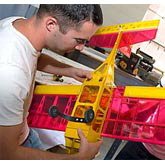Aerospace careers off to a flying start

U students win first at Aero Design West
Students from the University of Minnesota's Department of Aerospace Engineering and Mechanics (AEM) competed this spring in Aero Design West, a contest that drew dozens of teams from the United States, plus several from Poland, Mexico, and Venezuela, and required them to utilize the whole of their aerospace engineering and mechanics education. Their task was to produce an aircraft that met design goals and specifications; namely, to carry a substantial payload relative to aircraft weight.
The competition was the culmination of AEM's senior design class series, in which students choose from a number of projects in the fall semester of their senior year. Students often design an aircraft or fulfill design objectives related to flight, like autonomous refueling, under guidance from industry mentors.
In a competition well known for spectacular crashes, planes from the University held up and returned safely. The U students took first place overall in the "micro class" when their 17-ounce plane carried approximately twice its weight. The micro class team also took second place for their written and oral report on the aircraft. The "regular class" team took 11th place overall.
"The goal of the 'micro class' was to successfully carry a maximum payload while designing an aircraft to be as small and light as possible," says team member Jordan Stewart. "To effectively do this, we needed to make careful compromises between eliminating as much weight from our design while maintaining structural strength." The final aircraft was just over 30 inches nose to tail, with a wingspan of 43 inches. It stood about 12 inches from the top of the fuselage to the ground.
AEM students haven't always fared so well--pieces of crashed aircraft from the past are displayed for a bit more than nostalgia's sake in AEM's shop.
Scott Wigen, lead team member for the "regular class," describes the competition as an overall beneficial experience. "My entire team worked really well together, and each person brought something positive to the airplane," he says. "This was an extremely challenging project to design and build, but seeing the airplane perform so well was very gratifying and was the real culmination of our aerospace education."
